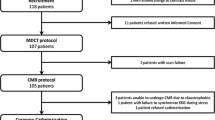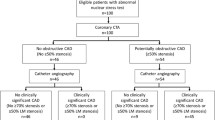Abstract
Exclusion of ischemia is important in patients with newly diagnosed systolic heart failure (HF). We prospectively compared standard-of-care invasive catheter angiography (iCA) and echocardiography to a novel non-invasive strategy of both Coronary Computed Tomographic Angiography (CCTA) and Cardiovascular MRI (CMR) to determine the etiology of myocardial dysfunction Prospective data were collected from consecutive patients referred for iCA to investigate echocardiographically-confirmed new onset HF. CMR (1.5T GE) and dual source CCTA were performed within 2–7 days of iCA. Results were blinded and separately analyzed by expert readers. 426 coronary segments from 28 prospectively enrolled patients were analyzed by CCTA and quantitative iCA. The per-patient sensitivity and specificity of CCTA was 100% and 90%, respectively, negative predictive value (NPV) 100%, positive predictive value (PPV) 78%. Mean ejection fraction by CMR was 24%. Presence of ischemic-type LGE on CMR conferred a 67% sensitivity, 100% specificity, 90% NPV and 100% PPV. Combining CCTA with CMR conferred 100% specificity, 100% sensitivity, 100% PPV and 100% NPV for detection or exclusion of coronary disease. In patients with negative CCTA all invasive angiograms could have been avoided. In addition, two patients with no ischemic LGE by CMR had severe coronary disease on both CCTA and iCA, indicating global hibernation. This is a noteworthy finding in contrast to previous reports which suggested that absence of LGE rules out significant CAD. CCTA with CMR in newly-diagnosed HF enables non-invasive assessment of coronary artery disease, the severity and etiology of myocardial dysfunction and defines suitability for revascularization. Absence of ischemic-type LGE at CMR does not exclude CAD as a cause of LV dysfunction. A first-line strategy of functional and anatomic imaging with CMR and CCTA appears appropriate in newly diagnosed HF.




Similar content being viewed by others
Abbreviations
- CCTA:
-
Cardiac computed tomographic angiography
- CMR:
-
Cardiovascular magnetic resonance.
- HF:
-
Heart failure
- LGE:
-
Late gadolinium enhancement
- iCA:
-
Invasive coronary angiography
References
Hunt SA, Abraham WT, Chin MH, Feldman AM, Francis GS, Ganiats TG, Jessup M, Konstam MA, Mancini DM, Michl K, Oates JA, Rahko PS, Silver MA, Stevenson LW, Yancy CW, Antman EM, Smith SC Jr, Adams CD, Anderson JL, Faxon DP, Fuster V, Halperin JL, Hiratzka LF, Jacobs AK, Nishimura R, Ornato JP, Page RL, Riegel B (2005) Acc/aha 2005 guideline update for the diagnosis and management of chronic heart failure in the adult: a report of the american college of cardiology/american heart association task force on practice guidelines (writing committee to update the 2001 guidelines for the evaluation and management of heart failure): developed in collaboration with the american college of chest physicians and the international society for heart and lung transplantation: endorsed by the heart rhythm society. Circulation 112(12):e154–e235. doi:10.1161/CIRCULATIONAHA.105.167586
Patel MR, Dehmer GJ, Hirshfeld JW, Smith PK, Spertus JA (2009) Accf/scai/sts/aats/aha/asnc 2009 appropriateness criteria for coronary revascularization: a report of the american college of cardiology foundation appropriateness criteria task force, society for cardiovascular angiography and interventions, society of thoracic surgeons, american association for thoracic surgery, american heart association, and the american society of nuclear cardiology: endorsed by the american society of echocardiography, the heart failure society of america, and the society of cardiovascular computed tomography. Circulation 119(9):1330–1352. doi:10.1161/CIRCULATIONAHA.108.191768
Scanlon PJ, Faxon DP, Audet AM, Carabello B, Dehmer GJ, Eagle KA, Legako RD, Leon DF, Murray JA, Nissen SE, Pepine CJ, Watson RM, Ritchie JL, Gibbons RJ, Cheitlin MD, Gardner TJ, Garson A, Jr, Russell RO Jr, Ryan TJ, Smith SC Jr (1999) Acc/aha guidelines for coronary angiography. A report of the american college of cardiology/american heart association task force on practice guidelines (committee on coronary angiography). Developed in collaboration with the society for cardiac angiography and interventions. J Am Coll Cardiol 33(6):1756–1824. doi:S0735-1097(99)00126-6
Ammann P, Brunner-La Rocca HP, Angehrn W, Roelli H, Sagmeister M, Rickli H (2003) Procedural complications following diagnostic coronary angiography are related to the operator’s experience and the catheter size. Catheter Cardiovasc Interv 59(1):13–18. doi:10.1002/ccd.10489
Achenbach S, Ropers U, Kuettner A, Anders K, Pflederer T, Komatsu S, Bautz W, Daniel WG, Ropers D (2008) Randomized comparison of 64-slice single- and dual-source computed tomography coronary angiography for the detection of coronary artery disease. JACC Cardiovasc Imaging 1(2):177–186. doi:S1936-878X(08)00009-0
Achenbach S, Ropers D, Kuettner A et al (2006) Contrast-enhanced coronary artery visualization by dualsource computed tomography—initial experience. Eur J Radiol 57:331–335
Miller JM, Rochitte CE, Dewey M, Arbab-Zadeh A, Niinuma H, Gottlieb I, Paul N, Clouse ME, Shapiro EP, Hoe J, Lardo AC, Bush DE, de Roos A, Cox C, Brinker J, Lima JAC (2008) Diagnostic performance of coronary angiography by 64-row CT. N Engl J Med 359(22):2324–2336. doi:10.1056/NEJMoa0806576
Stolzmann P, Leschka S, Scheffel H, Krauss T, Desbiolles L, Plass A, Genoni M, Flohr TG, Wildermuth S, Marincek B, Alkadhi H (2008) Dual-source ct in step-and-shoot mode: noninvasive coronary angiography with low radiation dose. Radiology 249(1):71–80. doi:10.1148/radiol.2483072032
Min JK, Shaw LK, Devereux RB, Okin PM, Weinsaft JW, Russo DJ, Lippolis NJ, Berman DS, Callister TQ (2007) Prognostic value of multidetector coronary computed tomographic angiography for prediction of all-cause mortality. J Am Coll Cardiol 50(12):1161–1170. doi:10.1016/j.jacc.2007.03.067
Ostrom MP, Gopal A, Ahmadi N, Nasir K, Yang E, Kakadiaris I, Flores F, Mao SS, Budoff MJ (2008) Mortality incidence and the severity of coronary atherosclerosis assessed by computed tomography angiography. J Am Coll Cardiol 52(16):1335–1343. doi:10.1016/j.jacc.2008.07.027
Earls JP (2009) How to use a prospective gated technique for cardiac ct. J Cardiovasc Comput Tomogr 3(1):45–51
Beek AM, Bondarenko O, Afsharzada F, van Rossum AC (2009) Quantification of late gadolinium enhanced cmr in viability assessment in chronic ischemic heart disease: a comparison to functional outcome. J Cardiovasc Magn Reson 11(1):6. doi:10.1186/1532-429X-11-6
White JA, Yee R, Yuan X, Krahn A, Skanes A, Parker M, Klein G, Drangova M (2006) Delayed enhancement magnetic resonance imaging predicts response to cardiac resynchronization therapy in patients with intraventricular dyssynchrony. J Am Coll Cardiol 48(10):1953–1960. doi:10.1016/j.jacc.2006.07.046
Larose E, Rodes-Cabau J, Pibarot P, Rinfret S, Proulx G, Nguyen CM, Dery JP, Gleeton O, Roy L, Noel B, Barbeau G, Rouleau J, Boudreault JR, Amyot M, De Larochelliere R, Bertrand OF (2010) Predicting late myocardial recovery and outcomes in the early hours of st-segment elevation myocardial infarction traditional measures compared with microvascular obstruction, salvaged myocardium, and necrosis characteristics by cardiovascular magnetic resonance. J Am Coll Cardiol 55(22):2459–2469. doi:10.1016/j.jacc.2010.02.033
Karamitsos TD, Francis JM, Myerson S, Selvanayagam JB, Neubauer S (2009) The role of cardiovascular magnetic resonance imaging in heart failure. J Am Coll Cardiol 54(15):1407–1424. doi:10.1016/j.jacc.2009.04.094
McCrohon JA, Moon JC, Prasad SK, McKenna WJ, Lorenz CH, Coats AJ, Pennell DJ (2003) Differentiation of heart failure related to dilated cardiomyopathy and coronary artery disease using gadolinium-enhanced cardiovascular magnetic resonance. Circulation 108(1):54–59. doi:10.1161/01.CIR.0000078641.19365.4C
Soriano CJ, Ridocci F, Estornell J, Jimenez J, Martinez V, De Velasco JA (2005) Noninvasive diagnosis of coronary artery disease in patients with heart failure and systolic dysfunction of uncertain etiology, using late gadolinium-enhanced cardiovascular magnetic resonance. J Am Coll Cardiol 45(5):743–748. doi:10.1016/j.jacc.2004.11.037
Raff GL, Abidov A, Achenbach S, Berman DS, Boxt LM, Budoff MJ, Cheng V, DeFrance T, Hellinger JC, Karlsberg RP (2009) Scct guidelines for the interpretation and reporting of coronary computed tomographic angiography. J Cardiovasc Comput Tomogr 3(2):122–136. doi:10.1016/j.jcct.2009.01.001
Austen WG, Edwards JE, Frye RL, Gensini GG, Gott VL, Griffith LS, McGoon DC, Murphy ML, Roe BB (1975) A reporting system on patients evaluated for coronary artery disease. Report of the ad hoc committee for grading of coronary artery disease, council on cardiovascular surgery, american heart association. Circulation 51(4 Suppl):5–40
Petranovic M, Soni A, Bezzera H, Loureiro R, Sarwar A, Raffel C, Pomerantsev E, Jang I-K, Brady TJ, Achenbach S, Cury RC (2009) Assessment of nonstenotic coronary lesions by 64-slice multidetector computed tomography in comparison to intravascular ultrasound: evaluation of nonculprit coronary lesions.[see comment]. J Cardiovasc Comput Tomogr 3(1):24–31
Ginns J, Hansen M, Pincus M, Slaughter R (2008) Assessment of indeterminant coronary artery stenosis: a comparison of ct coronary angiography with intravascular ultrasound. Heart, Lung Circ 17:S64–S65
Strugnell WE, Slaughter RE, Riley RA, Trotter AJ, Bartlett H (2005) Modified rv short axis series—a new method for cardiac mri measurement of right ventricular volumes. J Cardiovasc Mag Res 7(5):769–774
Lubbers DD, Janssen CH, Kuijpers D, van Dijkman PR, Overbosch J, Willems TP, Oudkerk M (2008) The additional value of first pass myocardial perfusion imaging during peak dose of dobutamine stress cardiac mri for the detection of myocardial ischemia. Int J Cardiovasc Imaging 24(1):69–76
Bruder O, Schneider S, Nothnagel D, Dill T, Hombach V, Schulz-Menger J, Nagel E, Lombardi M, van Rossum AC, Wagner A, Schwitter J, Senges J, Sabin GV, Sechtem U, Mahrholdt H (2009) Eurocmr (european cardiovascular magnetic resonance) registry: results of the german pilot phase. J Am Coll Cardiol 54(15):1457–1466. doi:10.1016/j.jacc.2009.07.003
George RZ, Kitagawa A, Chang K, Miller HJ, Bluemke JM, Becker DA, Texter L, Lardo J, Lima AC (2009) Adenosine stress 64 and 256 row detector computed tomography angiography and perfusion imaging: a pilot study evaluating the transmural extent of perfusion abnormalities to predict atherosclerosis causing myocardial ischemia. Circ Cardiovasc Imaging 2(3):174–182. doi:10.116/CIRCIMAGING.108.813766
Hundley WG, Bluemke D, Bogaert JG, Friedrich MG, Higgins CB, Lawson MA, McConnell MV, Raman SV, van Rossum AC, Flamm S, Kramer CM, Nagel E, Neubauer S (2009) Society for cardiovascular magnetic resonance guidelines for reporting cardiovascular magnetic resonance examinations. J Cardiovasc Magn Reson 11((1):5. doi:10.1186/1532-429X-11-5
Hendel RC, Patel MR, Kramer CM, Poon M, Carr JC, Gerstad NA, Gillam LD, Hodgson JM, Kim RJ, Lesser JR, Martin ET, Messer JV, Redberg RF, Rubin GD, Rumsfeld JS, Taylor AJ, Weigold WG, Woodard PK, Brindis RG, Douglas PS, Peterson ED, Wolk MJ, Allen JM (2006) Accf/acr/scct/scmr/asnc/nasci/scai/sir 2006 appropriateness criteria for cardiac computed tomography and cardiac magnetic resonance imaging: a report of the american college of cardiology foundation quality strategic directions committee appropriateness criteria working group, american college of radiology, society of cardiovascular computed tomography, society for cardiovascular magnetic resonance, american society of nuclear cardiology, north american society for cardiac imaging, society for cardiovascular angiography and interventions, and society of interventional radiology. J Am Coll Cardiol 48(7):1475–1497. doi:10.1016/j.jacc.2006.07.003
Acknowledgments
Dr Mark Hansen and Dr Adrian Khoo for assistance with CT data analysis, and to the staff at the Centre for Cardiovascular Imaging, Prince Charles Hospital.
Conflict of interest
Dr Hamilton-Craig is supported by grants from the National Heart Foundation of Australia, the Queensland International Fellowship, and the University of Washington Trans-Pacific Fellowship. The authors report no conflicts of interest.
Author information
Authors and Affiliations
Corresponding author
Rights and permissions
About this article
Cite this article
Hamilton-Craig, C., Strugnell, W.E., Raffel, O.C. et al. CT angiography with cardiac MRI: non-invasive functional and anatomical assessment for the etiology in newly diagnosed heart failure. Int J Cardiovasc Imaging 28, 1111–1122 (2012). https://doi.org/10.1007/s10554-011-9926-y
Received:
Accepted:
Published:
Issue Date:
DOI: https://doi.org/10.1007/s10554-011-9926-y




